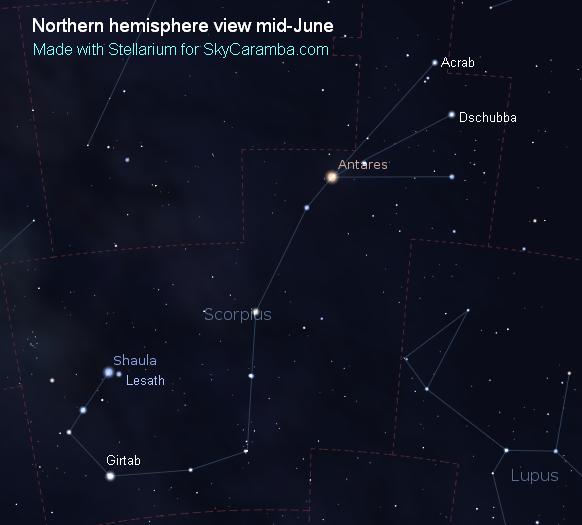SkyCaramba astronomy blog for the week ending June 18, 2011
If we could go to the center of the Milky Way Galaxy, we’d pass a bright orange star on the way. It’s called Antares and it’s part of the constellation Scorpio, the scorpion. You can see it if you live south of 60° north. Antares is a little over 600 light years away. The center of the galaxy is another 27,000 light years beyond it.
Antares is 10,000 times as bright as the sun if we consider only the light we can see. There’s many times more energy than that when its infrared output is taken. Antares is huge. If it could replace our home star, it would reach out as far as the asteroid belt between Mars and Jupiter.
It’s not necessarily because opposites attract, but Antares has a much dimmer blue companion. You’ll need a large telescope to see it unless you wait for the moon to pass in front of them. While the bright orange star is blocked from view, the dim blue one may briefly emerge from the glare in a small scope. Such occultations by the moon will happen a few dozen times from 2023 to 2028.
Several sources say Antares B looks green next to Antares A. There are no truly green stars. It’s a trick on the eye played by the bright red-orange glare.
Ares is the ancient Greek name for Mars. The name Mars came from the Romans a few centuries later. To the Greeks, Antares meant rival of Mars because the star and the planet have about the same color. Jack Horkheimer of the TV show Stargazer (at one time Star Hustler) said he was glad the Romans didn’t start calling the star Antmars!
To Latin and Arab speaking people, Antares was the heart of the scorpion. It’s not hard to imagine the stars arranged like a hook southeast of Antares representing a scorpion’s tail. On the opposite side of Antares, what used to be the insect’s claws are now part of Libra. Some of the stars in Libra still have names that refer to a scorpion’s claws.
Other stars in Scorpio are Acrab (an Arabic word for scorpion), Dschubba (Arabic for forehead), Girtab (Sumerian for scorpion), and Shaula (very aptly, Arabic for stinger).
Find Scorpio far in the south during the late evenings of June if you live at a middle northern latitude. It’s much higher if you live closer to the equator. And it’s right overhead from middle southern latitudes.
Those of you who’ve read SkyCaramba for a few months will recall that Scorpio is on the opposite side of the sky as Orion. The old legends say the tiny insect felled the mighty hunter after he boasted about what a great hunter he was. The gods immortalized them both in the heavens but thought it wise to put them as far apart as they could. Each enters the celestial stage only when the other exits.
Now let that be a lesson for you about pride and the stars.

